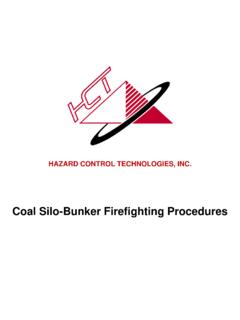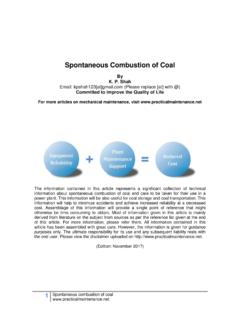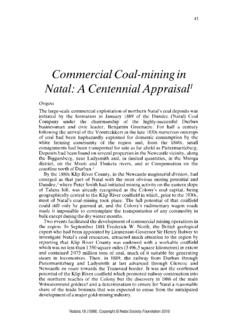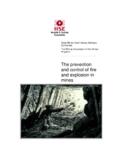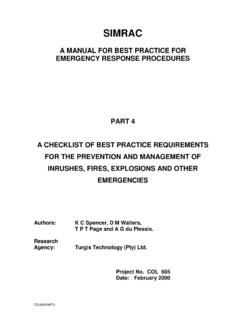Transcription of Fire Protection Guidelines for Handling and Storing PRB Coal
1 June 3, 2013 fire Protection Guidelines for Handling and Storing PRB Coal By Edward B. Douberly The Powder River Basin (PRB) Coal Users Group has developed recommended fire -prevention practices/ Guidelines for plants that burn PRB coal by itself or in blends. The Guidelines are not equipment-specific because the physical layouts of coal- Handling facilities vary significantly and because all fires are unique. The Guidelines also are not comprehensive; their purpose is to recommend general practices that must be adapted for the specific needs of your plant. The Guidelines provide information about three areas: fire prevention and detection, firefighting equipment and training, and firefighting. fire Prevention and Detection Operators familiar with the unique requirements of burning PRB coal will tell you that it s not a case of if you will have a PRB coal fire , it s when.
2 The prevention of fires and explosions is the foremost objective for any plant burning PRB coal. Although prevention is cheaper than repairing fire and explosion damage, its costs always seem difficult to justify. fire prevention must be addressed in the following areas. Housekeeping. Housekeeping means controlling dust and preventing spills. For example, float dust must be contained within transfer points and spillage from belts must be minimized. The accumulation of PRB coal below a conveyor or on conveyor parts can contribute to spontaneous combustion. Float dust either in the air or settled on beams, pipes, conduits, equipment, and fixtures provides fuel for explosions. A manual, daily washdown with a hose is beneficial, but it generally is not totally effective in removing PRB coal debris from under conveyors or from overheads (Figure 1). 1. An extreme case of PRB coal accumulation at the tail of a conveyor not designed for PRB coal.
3 Courtesy: Utility FPE Group Inc. Fixed washdown systems designed for 100% coverage are commercially available, greatly reduce labor costs, and significantly improve housekeeping over manual washdown. Plants that have installed these systems report being satisfied with their performance. Preplanning. For planned outages, operators should take every precaution to ensure that all idle bunkers and silos are completely empty and verify that by visual checks. Bunkers and silos should be thoroughly cleaned by washing down their interior walls and any interior structural members but not their horizontal surfaces. Idle bunkers and silos that contain PRB coal should be monitored frequently for signs of spontaneous combustion by using CO monitors, infrared scanning, or temperature scanning. Don t rely just on your senses by the time you see or smell burning coal, a fire is already under way (Figure 2).
4 2. Immediate response is required when an odor of coal roasting or burning is detected coming from a silo, bunker, or hopper. Delays in taking action only allow the rate of burning to increase. Courtesy: Utility FPE Group Inc. Some plants inert bunkers/silos of PRB coal with carbon dioxide (CO2) when they are expected to sit idle. For this practice to be effective, the enclosure must be completely sealed especially the bottom cone, because CO2 is about times heavier than air. The amount of CO2 needed to effectively inert an enclosure is pounds per cubic foot, so a silo measuring 22 ft in diameter and 55 ft high would require tons of CO2. A bulk supply of CO2 and an extensive piping system for bunkers/silos may be necessary to implement this system. Bunker and Silo Design. An active bunker or silo typically doesn t experience a fire under normal operating conditions.
5 If a fire occurs while the bunker is actively moving coal, the bunker may have design irregularities that are contributing to coal bridging or some kind of stoppage. PRB coal is notorious for hiding within cracked weld joints and then spontaneously combusting. Although the construction of bunkers and silos differs from plant to plant, they share one function that is independent of age and design: maintaining the mass flow of PRB coal. When raw coal is loaded into a bunker or silo, size segregation begins to take place. Large chunks of coal tend to roll out to the periphery of the bin while smaller chunks and fines stay in the center. This size segregation facilitates air migration up along the sides of the bunker/silo. It also presents a practical firefighting challenge when using water applied from above: Water tends to rathole through voids and can bypass the seat of the fire .
6 Design changes in older plants may be required, such as eliminating flat bottoms in bunkers and obtaining free flow through bottom cones. If you don t have mass flow conditions, we recommend that you perform an evaluation of the cone s lining. Access to the interior of bunkers and silos for firefighting is one of the most important aspects of successful fire suppression and one of the most difficult to obtain. Ease of access is often severely limited; the PRB Coal Users Group recommends that you preplan how to access hard-to-reach spaces. You may need to install access ports around the bunker/silo and at various levels (Figure 3). 3. A firefighting access port retrofitted to a bunker not designed for PRB coal. Courtesy: Utility FPE Group Inc. Silos that are taller than 50 ft should be provided with access ports at various elevations to accommodate the injection of firefighting agents.
7 The specific location of these ports must be determined by analysis of the silo s design. Although directly attacking a fire using a piercing rod is most effective, using a rod on a fire in a silo taller than 55 ft is extremely difficult. You should consider installing a fixed hazard mitigation system zoned to apply an agent only at levels expected to be fire -prone. Use infrared thermography to locate fires and to determine the zone(s) that should be activated. fire and Gas Detection. A major consideration in minimizing the impact of fire is deciding where to install gas- and/or temperature-monitoring devices in bunkers and silos. Each type of instrument has its own application criteria that must be considered, but both have proven effective at early detection of fires at plants burning PRB coal. CO Monitoring. Monitoring for the presence of carbon monoxide is the way to find out soonest whether there is a fire in the making.
8 CO is an odorless, toxic gas that is liberated at the very early stages of incomplete combustion. CO is flammable at 12% to 75% volume in air (OSHA s permissible exposure limit for CO is 35 ppm at an 8-hour time-weighted average). Though it may be normal to experience a rise and fall of background levels of CO in bunkers and silos during normal operation, monitoring will provide notification if the gas begins to continually trend upward from background levels. Desired alarm set points can be determined after the normal background level of CO is determined for your particular plant. The best way to make use of CO monitoring is to watch for a continuing upward trend of CO rather than to wait for the level of CO to reach a specific set point. Thermal Monitoring. Thermal detection, using thermocouples, also can provide an indication of a fire inside a bunker or silo.
9 However, thermal detection will not provide the early warning that CO monitoring does. Thermal detection relies on the presence of heat to activate, so a fire may already be of considerable size before the thermal detector senses the excess heat. Infrared Scanning. Coal is a very good insulator, so a deep-seated fire may not produce extremely high temperatures on the exterior surfaces of a silo or bunker. Periodic monitoring of the bunker or silo using an infrared thermographic camera to scan the outside and/or inside of the enclosure is a common practice. Such a scan (Figure 4) provides a visual picture of the thermal condition of the coal and is especially helpful in pinpointing the exact location of a hot spot deep inside a silo or bunker. 4. A thermographic image of a PRB coal silo fire . The fire , shown by the lighter horizontal strip, follows a weld seam around the contour of the silo.
10 The fire layer is approximately 5 ft in depth and is about 12 ft below the surface of the coal. Courtesy: Utility FPE Group Inc. Firefighting Equipment and Training Dealing with a fire inside a bunker or silo is a dangerous business that must be addressed with the correct equipment and training. There are two recommended methods for fighting a silo or bunker fire : using a fixed system installed inside the enclosure and/or using a special tool called a piercing rod. Experience indicates that the very best method of attack is to get the extinguishing agent directly to the seat of the fire . With proper preplanning, you will usually have plenty of time to deal with the fire if you have an organized and thoughtful game plan. Fixed Hazard Mitigation Systems. Fixed (permanent) systems installed inside bunkers or silos must be designed specifically for that enclosure.
